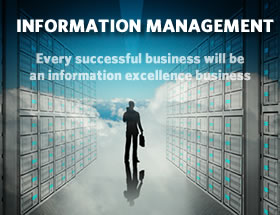 Information management is complex but as a manager you need to understand its essence in this day and age for a myriad of reasons.
Information management is complex but as a manager you need to understand its essence in this day and age for a myriad of reasons.
It seems like a daunting challenge. Understanding information management – from input, classification and actual management (Business Process Management, record management, content management, collaboration etc.) to storage and output of information. Fortunately what we really need to know is how to master the information value chain in a holistic way and with the business goals and the end in mind from the very start.
Information management (and in the context of this guide, Enterprise Information Management or EIM), is complex and seems overwhelming for many reasons. There are so many tasks, information sources, questions, critical connections and processes involved. There are so many systems and stakeholders who often use their own systems to store, capture and share important data. There are so many priorities and evolutions. There are disconnects between the back end and front office. And, last but not least, there is just so MUCH information and data, ever more unstructured data, big data, small data, fast data, data everywhere – it keeps growing at an astonishing pace.
For business executives trying to figure out how information can help them solve pressing challenges, make the business run smoother, address the needs of workers and customers, let alone find new ways to generate business value, information management feels like rocket science. The good news: your mission is to create the awareness, culture and conditions to capture, extract and leverage the value in the information of your business and ecosystem to start with. A holistic information management approach, as we strive to have in Enterprise Information Management, helps fitting the pieces of the information puzzle and all its parts – from Enterprise Content Management to data management and analytics, actions and – connected – outcomes.
The need for information management excellence
The complexity of (enterprise) information management often turns out to be a problem. A big problem for executives who don’t always see the essence as information management tends to be dealt with outside of the ‘business’ part of the organization and in silos such as Enterprise Content Management. Even if we understand its importance, as many do, seeing the importance of information (management) is not the same as de facto seizing the benefits.
Moreover, as executives we already have so much going on. As if it isn’t enough that we have to digitally transform our processes and businesses, deal with increasing competition and economic challenges, respond to the demands of changing customers and workers, and have to meet short-term, mid-term and long-term business goals, we now also need to understand the essence of this complex end-to-end matter of information management and even how it plays a role in areas such as CX (customer experience) optimization and innovation. And it gets worse: understanding how to make sense of all this information, moving towards a more intelligent information management approach and being smart about content and content management isn’t even enough anymore. Data is nothing less than a core asset and information is rapidly becoming a very tangible and even disruptive one.
[mks_pullquote align=”right” width=”250″ size=”20″ bg_color=”#00a6ed” txt_color=”#ffffff”]DX (Digital Transformation) Leaders Must Treat Data as an Asset (IDC)[/mks_pullquote]
Competitors right now are eating away revenues or preparing to disrupt our businesses/industries because they are better at understanding and using information.
Because they understand that digital transformation is about 1) information, 2) people, 3) experiences, 4) speed/timing, 5) convenience, 6) processes/automation and 7) interconnectedness/collaboration.
Seeing the big picture of information and information management
We don’t just need to master information management, we also have to achieve information management excellence and ‘activate’ our information, put it at work, unlock the value in it.
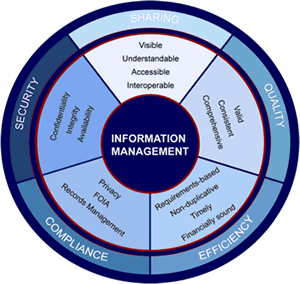
Fortunately we don’t have to understand nor master everything at once. It starts with knowing what you NEED to know, what your customers, workers, partners and managers want you to know and looking at information management from a holistic perspective and some distance helps you solve many of the other challenges you have as an executive.
And to do so it’s important to focus, ask the right questions and revert the views, while being smarter and at the same time more ‘simple’ about the challenges, priorities and ways to achieve them. You don’t need to know how a document scanner operates. You don’t need to understand Hadoop. Forget about the standards and technologies behind the Internet of Things. In fact, you don’t need to understand any technology at all. You just need to understand the essential questions, answers and evolutions across the various aspects of information management and regarding the role information plays and will play in your business.
Information management concerns the identification, optimization, custodianship and connection of information and information-intensive processes to innovate, achieve competitive advantages, generate business and customer value, and thrive in an era where information is a core business asset and an economic good
You need to see the big picture and have the right people and partners to help you see it and most of all deliver upon the actions you commit to. Remember the good old saying that it’s not the technology that matters (nor the information management details) but what you can do with it. And most of all: what your customers, workers, partners and other stakeholders want to do with it.
[mks_button size=”small” title=”Enterprise Information Management: the holistic reality of information” style=”squared” url=”https://www.i-scoop.eu/information-management/enterprise-information-management/” target=”_self” bg_color=”#0b99bc” txt_color=”#FFFFFF” icon=”” icon_type=””]
People, processes, technologies: information management with purpose
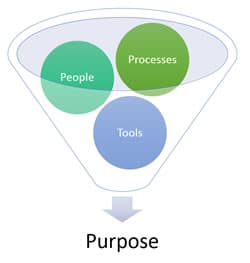
Before diving deeper into the role of information for your business and its future (and that’s hardly a dramatization) and the various elements of information excellence, it’s important to realize that information management only works if its traditional mix of people, process(es) and tools/technologies is right.
Too much focus on technology and not enough on people and process is deadly. In a nutshell it’s about people (workers, customers,…) enabled by knowledge and actions through connected processes, working together to achieve a goal using the proper technologies and taking into account the information lifecycle whereby both the end goals (purpose) and intermediate goals drive the decisions on what information is needed where and when, using which systems and processes for which end in mind.
What is information management? It depends on whom you ask in a way as information management and enterprise content management are often used interchangeably (more on the differences) and Enterprise Information Management is again something else than ‘traditional’ information management.
You might know the, among information management professionals, well-known illustration of the information management and ECM reality by AIIM (The Global Community of Information Professionals) from the Enterprise Content Management perspective below (again, note that information management and Enterprise Content Management are not the same).
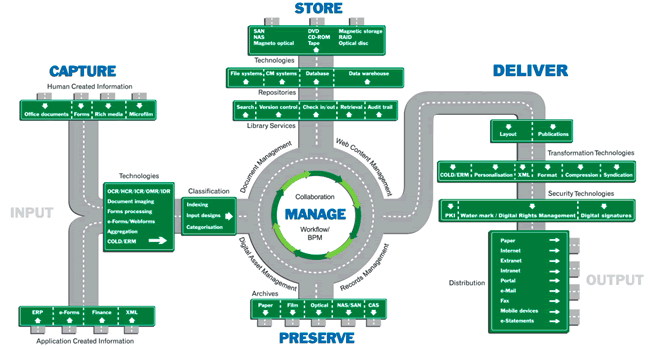
Look at all those elements and the many tasks and questions behind them. Data needs to be accurate, security matters, there are legal challenges, you need to turn captured information into knowledge and outcomes, you need to connect data and information silos, there are many systems and processes, information needs to be available at so many places, governance matters, the number and variety of input and output channels, sources and scenarios is huge, etc.
And this illustration has been going around for quite some time. It was made before anyone talked about the Internet of Things, social business or the evolutions towards an algorithm economy. It was even made before we talked about the critical role of information in customer experience management, digital transformation or new ways of working. And it doesn’t even take into account the information flows across various business divisions and functions. Just imagine. Complexity all over the place. Or so it seems.
Why information management should matter to management and the boardroom
Why would you, as a manager or business executive, even care? Isn’t all this for information professionals, IT managers and CIOs, Chief Data Officers or technical people? Well, it isn’t. It never really was but now it certainly isn’t anymore.
For starters, you can’t leave information as such and thus the way it is managed and organized out of the boardroom anymore (including the protection of it, a.k.a. “security”). Information is not just the lifeblood of organizations and the glue of human interactions and processes: it’s a key business asset and even an economic good in today’s and tomorrow’s economy. An economy that is characterized by a genuine information renaissance as Gartner calls it.
Defining and redefining information management: a matter of perspective
Information management can be defined from the information perspective as Wikipedia does. Quote: “Information management (IM) concerns a cycle of organizational activity: the acquisition of information from one or more sources, the custodianship and the distribution of that information to those who need it, and its ultimate disposition through archiving or deletion”. In other words: the information lifecycle and the processes, activities and stakeholders involved in it as Wikipedia further elaborates.
However, here is an alternative definition that sets the tone for how we need to think about it: “Information management concerns the identification, optimization, custodianship and connection of information and information-intensive processes to innovate, achieve competitive advantages, generate business and customer value, and thrive/survive in an era where information is a core business asset without which no business goals can be achieved and an economic good as such”.
See the difference? The latter definition is far more in line with the priorities and the goals of Enterprise Information Management.
[mks_button size=”small” title=”Information management versus (Enterprise) Content Management” style=”squared” url=”https://www.i-scoop.eu/information-management/information-management-definition-enterprise-content-management/” target=”_self” bg_color=”#0b99bc” txt_color=”#FFFFFF” icon=”” icon_type=””]
The information value chain: realizing competitive benefits with information at the center
Back to the reasons why information management should matter to management and the boardroom. In the introduction we talked about the need to master the information value chain as a condition for business success. What do we mean by that and why is it important?
Research firm IDC urged organizations to master that famous information value chain – which also has to be differentiated – in order to gain competitive advantage in its 2015 “Information Digital Transformation MaturityScape”, report. When announcing it, IDC was crystal clear: “information is at the core of the new digital ecosystem”. Plain and simple.
Yet it does pose a challenge for many organizations as unstructured communications and data continue to explode (IoT being the next catalyst), information resides in silos and our businesses are not ready to have all it takes to master that information value chain and the key role of information management and information intelligence.
Neverthless, unlocking value from information is the journey ahead. IDC estimates that by 2020, the digital universe will reach 44 trillion gigabytes. That is not just huge (a tenfold increase over 2013), it is also the future of your business. Because behind each gigabyte sits a wealth of information waiting to potentially (when it makes business sense) to be unlocked and capitalized upon.
Although 2020 is not really THAT far away, IDC states that most organizations today are still at the beginning of their journey to extract value from – the exploding amounts of – information. Time to embrace – as IDC calls it – Information Digital Transformation and effectively use information as “a critical enabler of the digital transformation of enterprises”. The study looks at this information digital transformation or DX in various stages.
Organizations that master a differentiated information value chain gain competitive advantage, IDC says. We couldn’t agree more. Building that competitive advantage with information management starts today. Capturing and turning information into value and helping organization to get the core of the new digital ecosystem – information – right should be your mission. Improving existing and identifying new revenue streams is the goal.
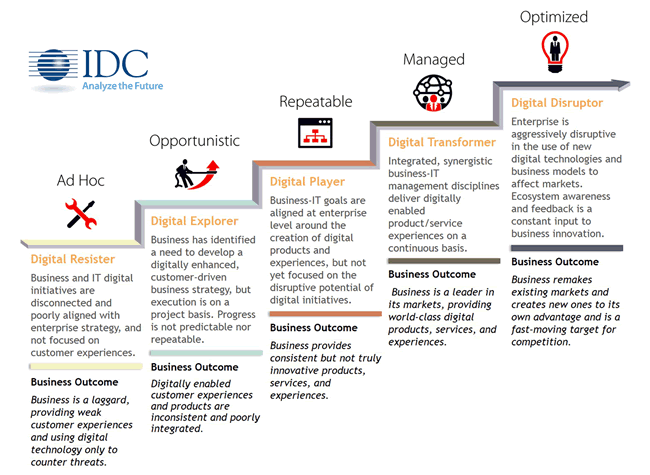
Information and data as an asset: between preach and practice
Saying that information is a key business asset is one thing (and no doubt you know it), treating it as such is another. Even if we realize the crucial role of information and thus information management and emphasize how important it is when asked about it in surveys or face-to-face discussions, there are disconnects between what we preach and what we practice. Far more than we think.
For starters, do you know what information your organization holds? The reality is that often we don’t. But even if we do the real question becomes if we know how to extract value from it and whether we have to skills and tools to do so. The answers to these questions are dissapointing. If we really value data as an asset it’s more than time to acquire the tools and mainly skills.
The lacking ability to create business value from information
Most organizations don’t think they are good at creating business value from information. The research paper ‘Managing enterprise information: meeting performance and conformance objectives in a changing information environment’, published in the International Journal of Information Systems and Project Management end 2014, is clear about that.
The paper, which covered the findings of an in-depth survey regarding the state of enterprise information management systems in organizations, looked at the drivers of EIM but also at how organizations gauged their own EIM capability.
It showed that only 42 percent of respondents rated their organizations as good or very good at creating business value from information. You can check it here (PDF opens).
The illustration below from the paper leaves no room for doubt regarding the perceptions of respondents regarding their abilities to create this value and other parameters regarding their EIM capability.
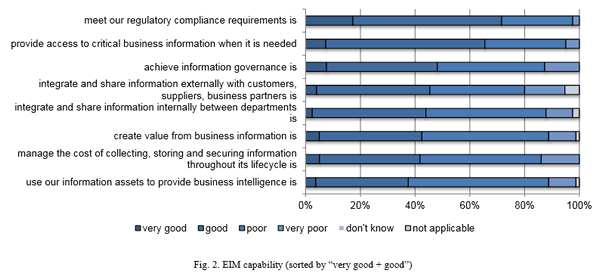
Source illustration and data: International Journal of Information Systems and Project Management, Vol. 2, No. 4, 2014, 5-36. Copyright © 2014, SciKA. Reprinting privileges granted by permission of SciKA (Association for Promotion and Dissemination of Scientific Knowledge).
Information maturity and capability: perceptions versus reality
According to more recent research by Iron Mountain and PwC, 67 percent of European and 75 percent of North American business leaders believe they make the most of their information. It’s quite a big difference with the before mentioned research. However, at the same time the research found that only 4 percent of business can extract full value from the information they hold.
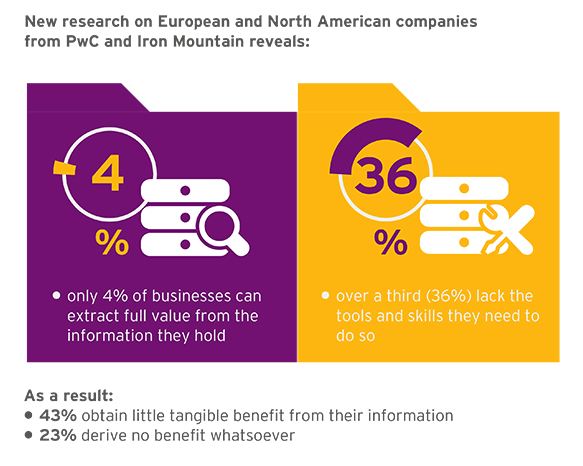
The (enterprise) information management business perception gap is huge. And it’s not just business executives that seem to struggle. The mindset of the CIO could use some change as well. Just consider that, according to a Colt survey of European IT decision makers, most CIOs favor intuition over data intelligence when making decisions. Data of course isn’t everything, nor is factual intelligence. Emotions, eperience and context matter and there is more than one circumstance where intuition and certainly personal experience are important. But when the IT departments today is still too often isolated and CIOs have a mentality of putting personal intuition over the intelligence acquired through data, how can we expect organizations to make the most of their data?
The security gap: the value of data versus how we protect it
Another good example of the challenges is security. No matter how you look at it, a major focus of cyber security is to secure, protect and monitor information and data, regardless of where it sits in the broadening perimeter. Although security is not easy and requires a holistic view (just as information management does) organizations that value information as a critical business asset put security high on the agenda and move it into the boardroom. After all: if data/information is cash, capital, currency, asset and the future of your business, you would do whatever it takes to protect it and make sure you protect it, right?
The impact of data breaches and stolen or compromised information is huge. Just take any recent major cyber-attack and look up what it has cost the company. And it’s not just about the direct costs and the theft of information. It’s also about trust, intangible capital, reputation and credibility, you name it.
[mks_pullquote align=”right” width=”250″ size=”20″ bg_color=”#00a6ed” txt_color=”#ffffff”]In 2015, 38% more security incidents were detected than in 2014. The theft of hard intellectual property increased 56%. [/mks_pullquote]
The ‘bad guys’ understand the value of information and data very well. That’s why they get increasingly sophisticated and smart about trying to get it. And why the number of security incidents keeps growing. According to PwC’s Global State of Information Security® Survey in 2015, 38% more security incidents were detected than in 2014. The theft of hard intellectual property increased 56%.
You might be surprised but actually in a way it’s good news, especially since lots of companies have boosted information security budgets by 24% and financial losses due to security incidents decreased between 2014 and 2015 (5% to be precise). So it seems organizations are realizing how important it is to take the necessary measures and they use ‘new technologies’ such as Big Data analytics to address the issues (more data on the overview page of The Global State of Information Security® Survey 2016). It’s a far better picture than in 2014 when the number of attacks rose to 48.2 million. Put in perspective: that’s over 117,000 incidents per day and it was a whopping increase of 48% over 2013 (and just look at those arrows go up, compared with the years before that).
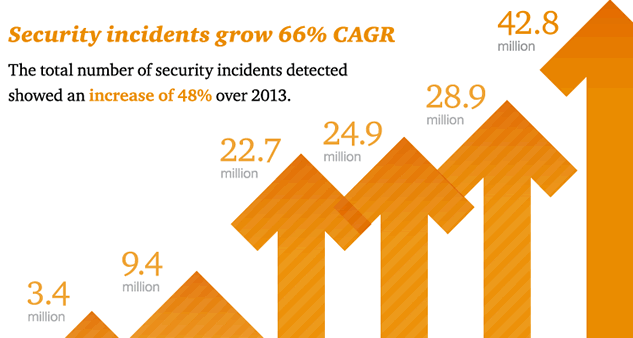
The bad news: it will not get (much) better, even if 2015 looks rosier than 2014. Information becomes even more important as an asset and economic good and the hackers and attackers are following the value. Moreover, and it is a much debated concern, the many evolutions that will generate even more information and data, including the many applications in the space of the Internet of Things, require even more attention.
In practice, we see that the place of security in the organization is not always where it should be and that few organizations really have solid security strategies that range from education and awareness of employees and good old network security to real-time security risk analysis or ethical hacking, to name just a few.
Despite all the apparent improvements in 2015, 42% of (large) organizations don’t have an overall information security strategy/approach PwC found. Furthermore, only 53% has an employee training and awareness program and only 49% conduct threat assessments. That means many organizations aren’t ready.
Let’s take one finding here that’s especially interesting for information management: the employee training and awareness part. Then think how data and information travel in a post-consumerization age and a world where personal content repositories and file sync and share tools are broadly adopted by your workers, shadow IT is ubiquitous and (the demand for) mobile access/capture/availability etc. are driving information management evolutions.
In other words: even if we recognize that information is an asset and even if we understand that it needs to be secured accordingly, we all too often both underestimate the real importance of information and still don’t take all security measures it more than deserves.
Intelligent information management: from records to engagement and insights
Information management is becoming more intelligent and so we increasingly hear about intelligent information management. Does that mean information management was dumb before? Not at all.
Intelligent information management (IIM) was traditionally defined as “a set of processes and underlying technology solutions that enables organizations to understand, organize and manage all types of data”. The keywords: processes, technology, data, management and understanding.
Understanding is about intelligence. But there’s more. Intelligent information management is about knowledge and, more specifically, knowledge that engages. The ‘intelligent’ part has several meanings of which we mention the two most important.
Information management goes cognitive and artificial intelligence
Intelligent information management is about content analytics, context, semantic understanding, so-called Smart Process Applications, automated interpretation, cognitive systems, smart connectivity with information flows, intelligent document recognition, algorithms – and, indeed, artificial intelligence overall (the only way organizations can handle, let alone extract meaning and value from big – and smaller- data).
Information management goes actionable engagement and context
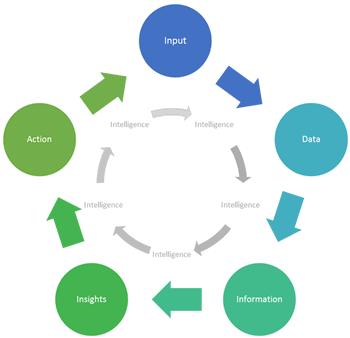
A second meaning, on top of all the intelligence going on in the ways information is recognized, understood and put into action, has to do with the shifting focus of information management on the outcomes. This is related with the evolution from so-called systems of record to systems of engagement and, here comes the intelligence again, more and more systems of insight.
A shift from managing records and information to processes to outcomes to intelligence and insights-based actions one could say, along with a shift from manual and human intervention to human decisions and creativity, based upon the context, meaning, analysis and triggers as a result of ever more automated and intelligent processes and systems in function of human and business needs.
Intelligent information management enables organizations to focus on what matters most. Documents and data become information and then intelligence – or knowledge – when they are transformed, understood, enriched and connected with the business processes, people and business functions who need that intelligence with clear actionable goals in mind. And intelligent technologies enable to make it more contextual, valuable and…intelligent than ever.
Digital transformation and how information becomes the center of a new economy
With digital transformation becoming the center of growth and innovation strategies, the role of information and the capability to understand it and put it into action is omnipresent in IDC’s 2016 forecasts.
[mks_pullquote align=”right” width=”250″ size=”20″ bg_color=”#00a6ed” txt_color=”#ffffff”]Only 4 percent of businesses can extract full value from the information they hold[/mks_pullquote]
To succeed in digital transformation, organizations need to effectively use information as “a critical enabler of the digital transformation of enterprises” the research firm emphasizes. It seems like the most obvious thing in the world. Yet, for many organizations it’s still hard to achieve.
If digital transformation will be at the center of corporate strategy it’s certainly worth diving deeper into the role and reality of information (management) in transformation.
- In 2016, 65 percent of large organizations will have committed to become information-based ones. Why? Because we understand the key role of information in transformation, customer experience, innovation, you name it. However, there is a big difference between commitment and capability as mentioned.
- The organizational focus will shift towards intangible capital, IDC claims – think about people, relationships and information as the connectors. Think about innovation capacity, data, customer experience, speed and agility, the ability to scale – anything needed to succeed in a rapidly changing and accelerating ecosystem.
- According to IDC by 2020 60 percent of the G2000 will have doubled productivity by digitally transforming many processes from human-based to software-based delivery. See the role of digital information and making sense of it using cognitize computing that obviously requires digital information to power this transition?
Leveraging data and information is not just an enabler of digital transformation anymore; it’s at the heart of a digital transformation economy.
Being more strategic about information management
We need to be more strategic about information management and everything that has to do with data in order to make sure we succeed. The gaps we mentioned in the “preach versus practice” part and the critical role of information in the digital transformation evolutions just require us too.
It’s time that we start looking very thoroughly at how to make sure that we capture, process and route the right data where it offers most value. And to understand where information sits, how it travels and how to tie it to business outcomes.
By being strategic about it all and looking at the business reality and priorities, we can make sure that we don’t belong to the two-thirds of enterprises that fail to meet best practice standards for data control as research found, to the many companies that waste considerable amounts on useless data as another study reports and – ultimately – to the majority that will not succeed in digital transformation as Forrester says.
[mks_pullquote align=”right” width=”250″ size=”20″ bg_color=”#00a6ed” txt_color=”#ffffff”]Poor-quality data on average costs organizations a whopping $14.2 million annually.[/mks_pullquote]
With a long list of data and cases indicating how poorly many businesses still unlock the value within the data that matter, let alone are able to properly manage it at all, it shouldn’t come as a surprise that in this reality the role of the Chief Data Officer is gaining ever more traction. But the CDO alone won’t do it if the cultural and strategic shift is not there.
Strategy starts with the business and customer outcomes in mind
Whether you need a document capture solution, an Enterprise Content Management system or any other document automation or information management solution: the key criterion driving the selection of the best answer to your needs is your individual business priority.
These business priorities are essentially defined by revenue/costs/profit, your business context and – increasingly – the user and the customer (experience). While this might seem obvious in practice it isn’t. AIIM’s Atle Sjekkeland recommends organisations to be more simple and smart when seeking ECM solutions for their challenges. We should start letting go of ‘old principles’ such as having a 300-page requirement document that is almost out-of-date before even the solution is live, Atle said.
Simple means making it easy for users but also focusing on the essence, the core drivers. Smart means informed and looking at the business challenge we seek to solve with our information management partners and solutions.
Going back to the source with the end goals as drivers
CIOs and information managers have an opportunity. It’s up to them to grab it by seriously reconsidering the whole information management chain from a value and future growth perspective.
But then they need to act now as the work is far from done, starting with getting paper(work) out of the way, seeing where the value sits and capturing the data that matters in order to become truly data-driven by speeding up the route from data to insight and action.
In that regard, here is a quote from AIIM’s recent “Paper-Free Progress: Measuring Outcomes” Industry Watch paper: “Even among those who have transformed their back-office processes, there is still much work to be done to capture multi-channel customer communications and unify front-office response”.
Gaps again indeed. Just as we have customer experience gaps, the above mentioned information and data maturity gaps and those gaps in disjointed systems, divisions and processes as the AIIM paper reminds us. Let’s close them and get strategic about it, starting with the mandate to reduce paper and up the speed of digitization.
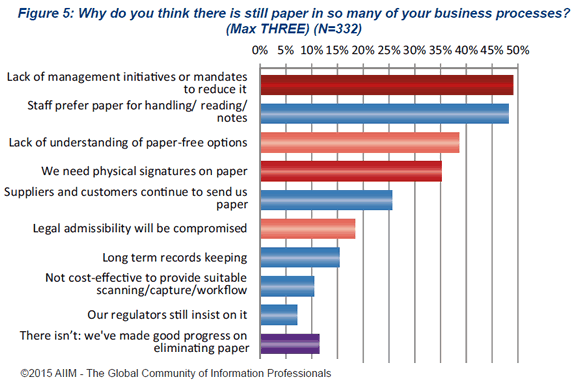
Strategy and prioritizing data and information: why, what and where
So, time to start at the source. In order to manage data and information, we obviously need to have “it”. While it’s easy to focus on all that data and information ‘out there’ and within our often disconnected repositories and systems of engagement, the core question is what information do we need in order to fulfil all our objectives and optimize our business in the broadest possible sense. It’s a topic we’ll cover soon as we keep expanding this ‘guide’.
The WHY and WHAT always comes first. That’s the language all executives speak: what do we want to achieve and why do we need WHICH information. Next comes the WHERE and HOW.
[mks_pullquote align=”right” width=”250″ size=”20″ bg_color=”#00a6ed” txt_color=”#ffffff”]Information is at the core of the new digital ecosystem (IDC)[/mks_pullquote]
There are a few main ways documents, data and information can enter the organization (the ‘input’ side of the AIIM model depicted earlier). On top of this information, there’s obviously also a bunch of information we already have. The question in this case also becomes what we can leverage and how in order to fulfil the business objectives. Keeping in mind the good old mantra ‘getting the right information to the right place for the right people/actions/systems at the right time in the right context etc.’.
Traditional and new ways of information input: beyond mail.
The first source of information is obviously everything that we ‘receive’ and decide to capture in order to achieve our goals: from the documents we receive via postal mail and ‘big data’ to the social feedback we listen to and the customer questions entering via a web form or a contact center rep. It’s clear that the variety of sources and formats has grown exponentially, as has the volume. It has led to a different view on (the organization) of capture as we’ll tackle later. Still, paper remains a major challenge in this regard.
Connecting with data sources and providers: your future.
This is also something we’ll cover more in depth later because it’s essential for the future. Information is ubiquitous but, depending on the goals, we don’t always dispose of the information we need to reach these objectives. This is where information and data are becoming economic goods: when getting ACCESS to information is essential. A typical example is marketing: it’s increasingly data-driven and businesses connect with external data sources in order to be more efficient.
Digitizing paper and unlocking the value in the information we ‘have’.
[mks_pullquote align=”right” width=”250″ size=”20″ bg_color=”#00a6ed” txt_color=”#ffffff”]Lack of management initiatives or mandates to reduce paper is the top reason why there is still so paper in so many business process.[/mks_pullquote]
We have a huge amount of information sitting in our businesses and often we can’t use it. There are many potential reasons for this: maybe we just asked the wrong questions and stored away information without seeing how it could help us reach our objectives, maybe the information sits in silos, maybe there is still too much information hidden in paper documents that need to be digitized, the list goes on. Two examples. When a hospital decides to digitize health records (EHR) it usually doesn’t just want to save space. It also wants access to information that can be used to improve healthcare and the patient experience. And in customer service, when organizations want to connect the back office (let’s say the mailroom and traditional mail) and front office, it’s because contact center agents don’t have access to the information when and where it’s needed for customer service.
Information that gets automatically generated through analysis, interaction, devices and artificial intelligence.
[mks_pullquote align=”right” width=”250″ size=”20″ bg_color=”#00a6ed” txt_color=”#ffffff”]By 2020, the digital universe will reach 44 trillion gigabytes, a tenfold increase over 2013 (IDC)[/mks_pullquote]
Last but not least, and this is certainly also a topic we’ll develop more in depth, the increasing use of artificial intelligence, content analytics, connections with devices (the Internet of Things, essentially about data, automation and processes), along with self-learning and automated interaction systems, create information by themselves, fully automated and of course again in function of the goals we define.
[mks_button size=”small” title=”From document capture to omnichannel capture” style=”squared” url=”https://www.i-scoop.eu/information-management/document-capture-omnichannel-capture/” target=”_self” bg_color=”#0b99bc” txt_color=”#FFFFFF” icon=”” icon_type=””]